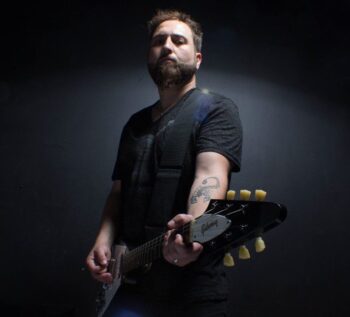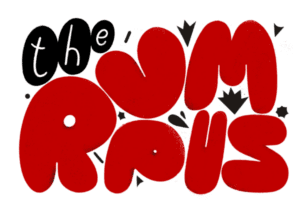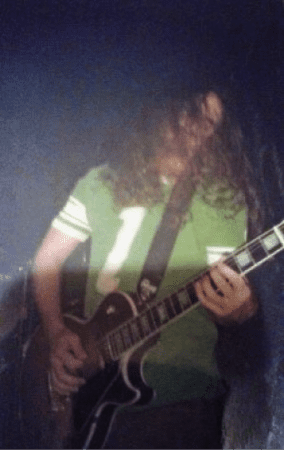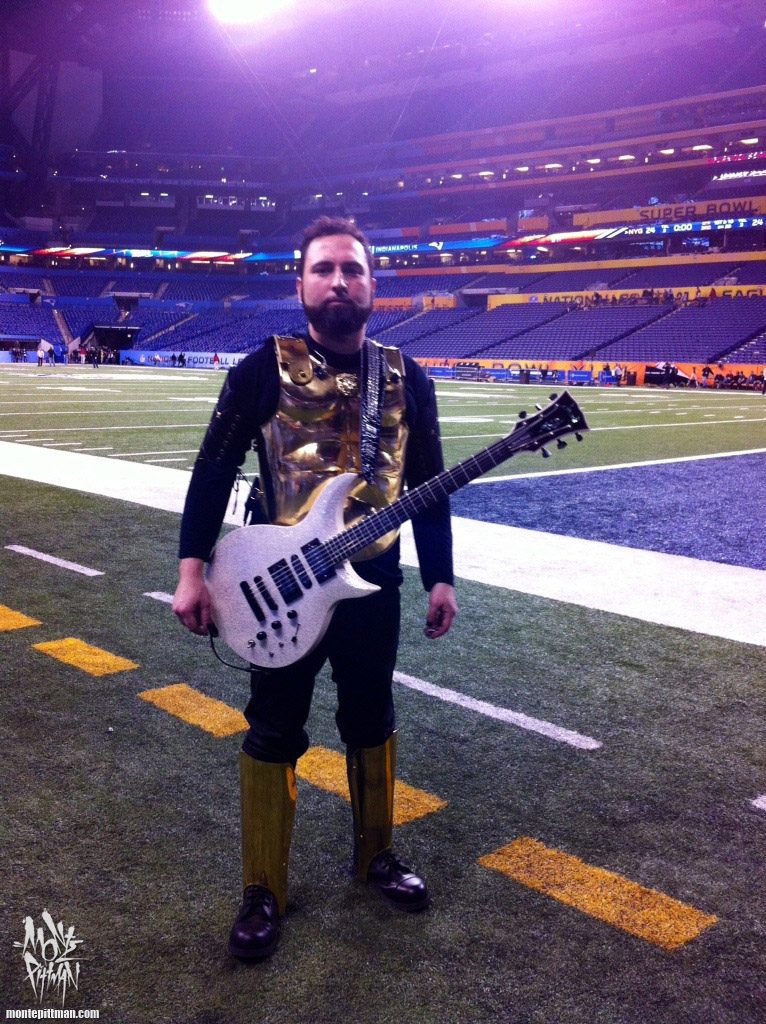
Welcome back to Sound & Vision, the Rumpus profile series that spotlights the creative talents of those working behind the scenes in the music industry. In this installment, we’ll hear from Monte Pittman.
Hailing from Longview, TX, Pittman moved to Los Angeles at age twenty-four to pursue his dream of becoming a professional musician. He made ends meet by working as a salesman at Guitar Center but soon left to teach guitar. As fate would have it, Pittman’s third student was the British filmmaker Guy Ritchie, who had just received a guitar from his then girlfriend, Madonna. Soon after, Pittman also became Madonna’s guitar teacher, and a month later, she invited him on stage at the David Letterman Show to promote her album Music. Since then Pittman has played guitar on all of Madonna’s live tours and albums and shares writing credits on some of her songs.
Pittman has also performed in the heavy metal band Prong, with Adam Lambert, and as a solo artist. He has received numerous honors for his exceptional guitar work, including being named “Best Solo Artist” by the Artists In Music Awards and winning a Career Achievement Award from the Hollywood F.A.M.E. Awards. I was excited to talk with him about seizing every opportunity and passing on to others what he’s learned.
***
The Rumpus: I understand radio was critical to your early exposure to music and your decision to pursue guitar as a career. Can you tell me about the radio scene in Longview, Texas, where you grew up?
Monte Pittman: Now Longview is a lot bigger but at the time it was a small town between Dallas and Shreveport, and we used to pick up all of the Shreveport radio stations. I was not a big fan of country stuff at all back then. Now I love it—I think because it makes me think of home—but at the time I was totally into rock. And I loved this one Shreveport station, 98 Rocks. They played stuff like Pink Floyd’s Animals and some obscure stuff like long deep cuts, and I also loved 99X out of Shreveport, which was more new wave.
In Longview itself there was a station called 96X that played all kinds of rock and they did metal shows, and also some shows featuring local music. I’d hear about all of these bands that would come through Dallas and Shreveport, which was a big deal for me because Longview was in what they call “the Bible belt.” MTV was not allowed. It was kind of like the movie Footloose. I wanted to play music ever since I can remember, but you kind of had to sneak it.
Rumpus: Did you ever get to see bands play live?
Pittman: Well, not as many as I would have liked to. If I had my way my first show would have been Ozzy on the “Ultimate Sin” tour with Metallica opening. They were going to play in Tyler, Texas, which was about thirty minutes away, but all of the churches protested.
Rumpus: So you snuck there—like the kids in Detroit Rock City who desperately wanted to see Kiss?
Pittman: Well, no. I wouldn’t have snuck out because I’d have been afraid of getting caught (laughs) but in the end the churches won and the show never happened! On top of everything else, Ozzy had recently pissed on the Alamo, and that didn’t go over too well in Texas…
Rumpus: When did you first start playing guitar?
Pittman: I had a toy guitar when I was a kid. I’d break the strings from playing it so much that I’d use fishing line and the little grocery store plastic clips as picks. I got my first “real” electric guitar from my parents at Christmas when I was thirteen. At first I taught myself. I just wanted to do it so badly I somehow understood how it worked. But about a year later I was playing for my cousin and he asked if I knew any chords. I was like, “What are chords?” And he walked out of the room and told my dad, “You’ve got to get this boy guitar lessons.”
My parents found the best teacher in town, Robert Browning, and I’ve been going to him ever since. I’ll still call him up and say, “Hey—what scale can I play over this chord?” That’s the thing—there’s so much to learn! I always say you never stop learning.
Rumpus: When did you start playing in bands?
Pittman: Right around that time I met a friend and we started a band called Insanity. We had a few originals, and played a bunch of Metallica, Anthrax, Slayer, and stuff like that. We played our first gig at a local teen club called The Jungle where you had to be fifteen. I was only fourteen at the time, but they didn’t check IDs so we made it work. You know how it is when you’re a kid. Even when people don’t play anything they want to be in a band, and then they want to take over the world! (Laughs.) While I was working on that plan, I also played drums in my school jazz band, and I learned a lot about rhythm from that experience which benefitted my guitar playing. I also learned more complex chords and how to read from a chord chart. I’ve always liked all different styles of music as long as it’s guitar driven.
Rumpus: Tell me more about your decision to follow your dream to LA.
Pittman: I was like 23 or 24 and I had never been on an airplane until my friend and I decided to go to a Star Wars convention in Denver, and I was like, “Wow—this is easy.” So my cousin was living in LA at the time and I went there to go check it out. As soon as I got off the plane I was like, “I am moving here!” When I got back to Texas I told everyone and they were like, “Oh, whatever.” But I really did it as soon as I could. Just a couple of months later, I got a U-HAUL and headed out.
Rumpus: What were things like in LA at the time, musically and culturally?
Pittman: This was early 2000. Everything was changing. Guns N’ Roses was out. Limp Bizkit and Korn were in. My early shows were open mic nights playing out with an acoustic guitar because that’s what I had. But Prong was one of my favorite bands and pretty early on after I moved here I started playing with them.
Rumpus: How did that come about?
Pittman: LA is a great big city and real small town. I became friends with Ivan de Prume, who played drums in White Zombie, and at the time he had been jamming with Tommy Victor. Tommy was putting Prong back together, I knew all the songs, and we just hit it off immediately. Tommy and I ended up trading off bass and guitar in each other’s bands.
Watch Prong perform the song “Rude Awakening”:
Rumpus: Did you play metal exclusively at that time?
Pittman: My dream was always to be a professional musician and I never turned down any gigs. Sometimes I tried to pass gigs on to my friends and they turned them down because they didn’t like the musical style or whatever. But I think it’s bad luck to turn down a gig because you never know what you’ll learn from it or what it will lead you to.
Rumpus: And how did that attitude lead you to Madonna?
Pittman: While I was playing around town I also worked at Guitar Center and people always came in looking for guitar teachers. I actually quit the sales job but left behind some cards saying I was offering lessons. Guy Ritchie turned out to be my third student. Madonna had bought him a guitar for his birthday and one day his assistant just called Guitar Center looking for a teacher, and that’s how he got my number. The assistant didn’t say who his boss was. I just got an address, and I went over to the house, and I started teaching Guy. Then Madonna also started studying with me, and about a month later she invited me to play with her on David Letterman. It was just one of those life changing experiences.
Rumpus: Wow.
Pittman: It was a Monday when she asked me, and I thought she was joking, but then I was on a flight to New York and we taped it on Thursday and it aired on Friday.
Watch Monte and Madonna perform live on Letterman:
Rumpus: Had you been specifically working with Madonna on “Don’t Tell Me”?
Pittman: She was getting ready for that single to come out and I was driving to her house one day for a lesson and I thought, “That’s D, A Minor, C, and G—that’s perfect for her as a beginning guitar player.” That’s what I’d often do: teach her to play the guitar parts to her own songs.
Rumpus: Can we talk a bit more about the guitar in Madonna’s music? Most people don’t think of her as being very guitar-focused.
Pittman: Madonna’s music is very eclectic. You’ve got songs like “Into the Groove” which aren’t very guitar-focused but you also have “La Isla Bonita” which is. And there is always atmospheric stuff like in “Live to Tell” or “Ray of Light.” There are eight guitar tracks in “Ray of Light”!
Watch Monte perform “Ray of Light” on Madonna’s Drowned World Tour:
Rumpus: Madonna has been named by Billboard as the top touring female artist of all time. Her shows are huge. I’m talking sold-out stadiums, the Super Bowl. Do you ever get stage fright when you’re performing with her?
Pittman: There’s only been one time I’ve been afraid to go on stage and that was actually at a European festival with Prong. We played right after the band Napalm Death. They were so good, so brutal, and they had put on such a killer show that afterwards it was all dust and dirt and I thought, “Wow! We had better step it up!”
Rumpus: Let’s talk about your work as a solo artist. Your first album, 2009’s The Deepest Dark, reached the #1 spot on the Best-Selling Acoustic Albums list on CD-Baby. You raised over $65,000 on Kickstarter for your second album, 2011’s Pain, Love & Destiny—the most money raised by a rock musician at that time.
Pittman: Yes, the first album was just acoustic and vocals so I could recreate it anywhere. But eventually I started playing out with a full band, and when I decided to do a second album a friend told me about Kickstarter. At first I was reluctant, I didn’t want to ask friends for money, but then I learned more about what crowd funding was, and I realized I could offer lessons, play at private parties, and stuff like that to give back to my supporters. It just blew up.
Rumpus: Did you follow any particular strategy?
Pittman: I intentionally set the goal to be modest so that it was easy for fans to support me and easy for me to reach. One guy bought guitar lessons for his son for a year, and that helped right away. In fact I exceeded my goal in the first day, which boosted the campaign’s visibility and it got bigger and bigger from there.
Rumpus: From your perspective are there drawbacks to crowd funding?
Pittman: Well, for one thing I didn’t expect it to get so big, and I discovered the cost of sending CDs across the world meant there was little money left for making the record. At one point the post office clerk told me, “Hey, you can only send so many things at a time!”
For my second album, the campaign was right at the end of a Madonna tour and right before Christmas. People I’d enlisted to play house parties with me as incentives needed gear and I supported them—in retrospect it wasn’t the best timing and I didn’t have the newness of Kickstarter just taking off. By this time record labels were signing artists and then using crowd funding for their releases mostly to make it look like the bands had a successful fan base…
Rumpus: I’ve heard some artists now think of Kickstarter purely as a pre-sale mechanism, others as social media.
Pittman: Yes. The second campaign wasn’t as big but it did cover some of my studio costs, so that was still worth something. My third album was heavy—Originally I wanted to make it some acoustic, some heavy, and some blues, but I put out an EP of four acoustic songs and gave them to the producer Flemming Rasmussen. He’s worked with Metallica, Rainbow, Cat Stevens, and others, and he persuaded me to concentrate on the heavy stuff. We made plans for me to go to Copenhagen, where he lives, and that’s where we recorded my album The Power of Three.
Rumpus: Did Rasmussen also influence you to sign with a label this time?
Pittman: As we were making this album I thought, “There has to be someone who would want to get behind this.” I had dinner with Brian Slagel from Metal Blade Records, and I asked him for his advice. I played the album for him and he said, “I’ll sign you!” The Power of Three came out early this year and went up to #14 the same day Black Sabbath released the Ozzy era catalogue. (Laughs). The video for “Before the Mourning Son” has had over 80,000 views. More and more people write me on Twitter or Facebook.
Watch the video for “Before the Mourning Son”:
Rumpus: Are you currently touring in support of the release?
Pittman: Yes! In fact we have an upcoming show in Hollywood at Whiskey A Go-Go on September 27th. We’ll be filming a video that night too!
Rumpus: As you keep working with Madonna and on your solo work, do you still teach?
Pittman: When Madonna tours or studio work comes up, that takes top priority. But I still make my own music and I do still teach. I do “house calls” and I also teach kids a couple of days out of the week at the School of Rock in South Bay. It’s a great place, and it’s rewarding to see the kids learn and to pass on what I’ve learned.
***
This interview has been edited and condensed. If you’d like to recommend someone for “Sound & Vision,” drop Allyson a line here.
***
Feature photograph of Monte Pittman, credit: Michel Ambra. This and all other photographs courtesy of Monte Pittman.







